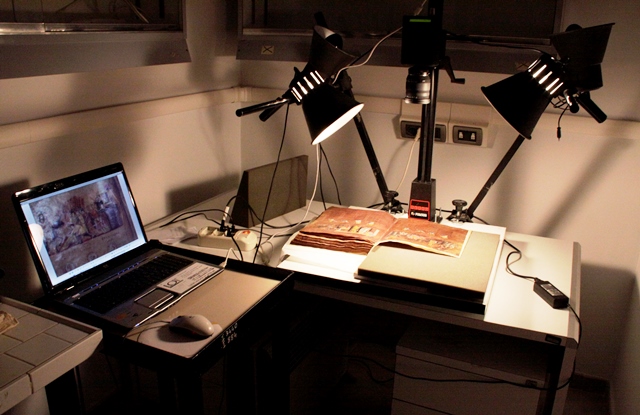Ultimo aggiornamento 4 August 2023

In the field of Cultural Heritage, and in particular in the study of polychrome surfaces, multispectral acquisitions (reflectographic and spectroscopic) are increasingly spreading among non-destructive techniques, which operate not only in the visible region, but also in the contiguous ones ultraviolet and near infrared (NIR).
These are physical methodologies which consist in investing the sample with primary radiations of different wavelengths (energy) and analyzing the signals which are emitted, in real time, following the interaction with the matter which constitutes it and which depend on its chemical constitution. The various investigations differ above all in the wavelength range of the primary radiation used which determines its penetration depth within the investigated artefact; depth obviously also linked to the nature of the material crossed. What has been said is particularly important in the investigations of artifacts made up of several superimposed layers.
The reflectographic techniques, allowing to obtain images, are obviously more immediate to understand and interpret, compared to the spectroscopic techniques which, on the other hand, provide a graph of the reflectance or absorbance as a function of the wavelength of the incident radiation. commonly referred to as the “spectrum”. In the Physics Laboratory there is a reflectance spectroscope with optical fiber probes that works in the UV-Visible-NIR (300-1700 nm) and a Fourier transform spectrophotometer that works in the mid-infrared (4000-400 cm-1) using, among other things, the non-destructive analytical technique ATR which involves the simple contact between the sample to be examined and a crystal with a high refractive index (in our case germanium or zinc selenide).
The reflectographic techniques used include visible fluorescence excited by ultraviolet radiation, near-infrared and false color reflectography.
The combined examination of the results obtained using these analytical techniques can, for example, be useful for identifying pigments and dyes.
Diagnostic investigations on works of high cultural value
- Parchment rolls Exultet 1, 2, 3 and Benediction conserved in the Diocesan Museum of Bari.
- Ottavio Pisani’s astrology book from 1613 kept in the Casanatense Library.
- Leonardo da Vinci’s drawings and “Code of Flight”.
- Drawing on translucent paper by Antonio Canal known as Canaletto (1697-1768) entitled “Canal Grande” which depicts a view of Venice.
Support to the SAF
In addition to the theoretical lessons, in the past year and in the first months of 2020 the following were examined:
- Artifacts object of five degree theses (Globe of the National Physics Institute of Sapienza, Chinese book of the Casanatense Library, Book of Psalms kept at the Abbey of Grottaferrata, Herbarium kept at the “Sapienza” University of Rome, Cinematographic films of the Istituto Luce).
Research and experimentation projects in progress
Characterization of tanning products in ancient skins and parchments with microanalytical techniques and infrared and UV-visible spectrophotometry (Physics and Technology).
Creation of a database of infrared spectra of pigments (Physics).

